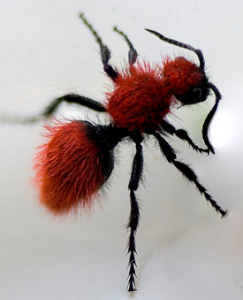Colorful Velvet Ants Only Look Cuddly!
By Chris Williams on August 18, 2015.
My son found a really colorful, fuzzy insect in our backyard. He put it in a jar and we tried to look it up on the Internet. We think it’s a velvet ant. What do velvet ants do because we’ve never seen one before?
G. F., Sterling, MA

Velvet Ant
First, tell your son not to touch that insect; he’s been lucky so far. That captured insect is not poisonous but it has a nasty sting. The velvet ant is not an ant at all. It’s in the same large grouping as ants, but it is actually a wasp. The female is about ¾ inch long, wingless, and looks like…you guessed it, a velvety ant. Velvet ants are indeed colorful, black with bright red, orange, or yellow bands of hairs. Their bright colors attract people but are actually meant as a warning to predators.
Velvet ants aren’t seen very often and they aren’t seen in large numbers since they are solitary wasps without a colony. The even rarer male velvet ant has wings and looks similar to the female, but he can’t sting. Velvet ants are parasites on other bees and wasps. The female lays her eggs in the pupal cocoons of ground-nesting bees or wasps. Her hatching larvae then feed on the pupae of their close relatives.
Velvet Ants Are Not a Problem If Left Alone
The bright colors and the fuzzy body make velvet ants appear very pettable, especially to children. Velvet ants are not aggressive, but the female does have a painful defensive sting which gives velvet ants the nickname of “cow killer!” She will sting if stepped on, or under attack, but she makes a squeaking warning sound before she does so.
Velvet ants are more common in the southern and western U.S. than here in New England. They also aren’t common in the yards of most homes since they prefer dry, open, sandy ground – not lawns. They are most common in mid-summer when they are seen running erratically over the ground. On rare occasions, one might find its way indoors. You can eliminate velvet ants from an area by (1) planting grass to cover the bare ground that they prefer, or by (2) eliminating the ground-nesting wasps or bees that they parasitize. Or, you can enjoy the occasional velvet ant…from a distance.
Craig Pemberton at English Wikipedia [CC BY-SA 3.0 or GFDL], via Wikimedia Commons